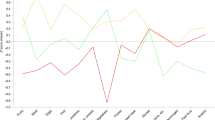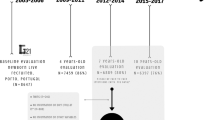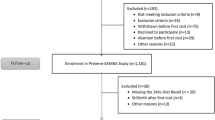Abstract
Background/Objectives:
The objective of this study was to identify dietary patterns in a cohort of 7-year-old children through cluster analysis, compare with patterns derived by principal components analysis (PCA), and investigate associations with sociodemographic variables.
Subjects/Methods:
The main caregivers in the Avon Longitudinal Study of Parents and Children (ALSPAC) recorded dietary intakes of their children (8279 subjects) using a 94-item food frequency questionnaire. Items were then collapsed into 57 food groups. Dietary patterns were identified using k-means cluster analysis and associations with sociodemographic variables examined using multinomial logistic regression. Clusters were compared with patterns previously derived using PCA.
Results:
Three distinct clusters were derived: Processed (4177 subjects), associated with higher consumption of processed foods and white bread, Plant-based (2065 subjects), characterized by higher consumption of fruit, vegetables and non-white bread, and Traditional British (2037 subjects), associated with higher consumption of meat, vegetables and full-fat milk. Membership of the Processed cluster was positively associated with girls, younger mothers, snacking and older siblings. Membership of the Plant-based cluster was associated with higher educated mothers and vegetarians. The Traditional British cluster was associated with council housing and younger siblings. The three clusters were similar to the three dietary patterns obtained through PCA; each principal component score being higher on average in the corresponding cluster.
Conclusions:
Both cluster analysis and PCA identified three dietary patterns very similar both in the foods associated with them and sociodemographic characteristics. Both methods are useful for deriving meaningful dietary patterns.
This is a preview of subscription content, access via your institution
Access options
Subscribe to this journal
Receive 12 print issues and online access
$259.00 per year
only $21.58 per issue
Buy this article
- Purchase on Springer Link
- Instant access to full article PDF
Prices may be subject to local taxes which are calculated during checkout

Similar content being viewed by others
References
Bamia C, Orfanos P, Ferrari K, Overvad H, Hundborg HH, Tjonneland A et al. (2005). Dietary patterns among older Europeans: the EPIC-Elderly study. Br J Nutr 94, 100–113.
Campain AC, Morgan MV, Evans RW, Ugoni A, Adams GG, Conn JA et al. (2003). Sugar-starch combinations in food and the relationship to dental caries in low-risk adolescents. Eur J Oral Sci 111, 316–325.
Corrêa Leite ML, Nicolosi A, Cristina S, Hauser WA, Pugliese P, Nappi G (2003). Dietary and nutritional patterns in an elderly rural population in Northern and Southern Italy: (I). A cluster analysis of food consumption. Eur J Clin Nutr 57, 1514–1521.
Costacou T, Bamia C, Ferrari P, Riboli E, Trichopoulos D, Trichopoulou A (2003). Tracing the Mediterranean diet through principal components and cluster analyses in the Greek population. Eur J Clin Nutr 57, 1378–1385.
Crozier SR, Robinson SM, Borland SE, Inskip HM (2006). Dietary patterns in the Southampton Women's Survey. Eur J Clin Nutr 60, 1391–1399.
Everitt BS, Landau S, Leese M (2001). Cluster Analysis, 4th edn. Arnold: London.
Gnanadesikan R, Kettenring JR, Tsao SL (1995). Weighting and selection of variables for cluster analysis. J Class 12, 113–136.
Golding J, Pembrey M, Jones R, the ALSPAC Study Team (2001). ALSPAC—The Avon Longitudinal Study of Parent and Children. I. Study methodology. Paediatr Perinat Epidemiol 15, 74–87.
Hearty AP, Gibney MJ (2009). Comparison of cluster and principal component analysis techniques to derive dietary patterns in Irish adults. Br J Nutr 101, 598–608.
James DC (2009). Cluster analysis defines distinct dietary patterns for African-American men and women. J Am Diet Assoc 109, 255–262.
Kant AK (2004). Dietary patterns and health outcomes. J Am Diet Assoc 104, 615–635.
Kant AK, Graubard BI, Schatzkin A (2004). Dietary patterns predict mortality in a national cohort: the National Health Interview Surveys, 1987 and 1992. J Nutr 134, 1793–1799.
Knol LL, Haughton B, Fitzhugh EC (2005). Dietary patterns of young, low-income US children. J Am Diet Assoc 105, 1765–1773.
Lee JW, Hwang J, Cho HS (2007). Dietary patterns of children and adolescents analyzed from 2001 Korea National Health and Nutrition Survey. Nutr Res Pract 1, 84–88.
Michels KB, Schulze MB (2005). Can dietary patterns help us detect diet-disease associations? Nutr Res Rev 18, 241–248.
Newby PK, Muller D, Tucker KL (2004). Associations of empirically derived eating patterns with plasma lipid biomarkers: a comparison of factor and cluster analysis methods. Am J Clin Nutr 80, 759–767.
Newby PK, Tucker KL (2004). Empirically derived eating patterns using factor or cluster analysis: a review. Nutr Rev 62, 177–203.
Northstone K, Emmett P, The ALSPAC Study Team (2005). Multivariate analysis of diet in children at four and seven years of age and associations with socio-demographic characteristics. Eur J Clin Nutr 59, 751–760.
Pryer JA, Cook A, Shetty P (2000). Identification of groups who report similar patterns of diet among a representative national sample of British adults aged 65 years of age or more. Public Health Nutr 4, 787–795.
Pryer JA, Rogers S (2009). Dietary patterns among a national sample of British children aged 1 1/2–4 1/2 years. Public Health Nutr 12, 957–966.
Rasanen M, Lehtinen JC, Niinikoski H, Keskinen S, Ruottinen S, Salminen M et al. (2002). Dietary patterns and nutrient intakes of 7-year-old children taking part in an atherosclerosis prevention project in Finland. J Am Diet Assoc 102, 518–524.
Reedy J, Wirfalt E, Flood A, Mitrou PN, Krebs-Smith SM, Kipnis V et al. (2010). Comparing 3 dietary pattern methods–cluster analysis, factor analysis, and index analysis–with colorectal cancer risk: the NIH-AARP Diet and Health Study. Am J Epidemiol 171, 479–487.
Samieri C, Jutand MA, Feart C, Capuron L, Letenneur L, Barberger-Gateau P (2008). Dietary patterns derived by hybrid clustering method in older people: association with cognition, mood, and self-rated health. J Am Diet Assoc 108, 1461–1471.
Song Y, Joung H, Engelhardt K, Yoo SY, Paik HY (2005). Traditional v. modified dietary patterns and their influence on adolescents' nutritional profile. Br J Nutr 93, 943–949.
Acknowledgements
We are extremely grateful to all the families who took part in this study, the midwives for their help in recruiting them, and the whole ALSPAC team, which includes interviewers, computer and laboratory technicians, clerical workers, research scientists, volunteers, managers, receptionists and nurses. The UK Medical Research Council, the Wellcome Trust and the University of Bristol provide core support for ALSPAC. This publication is the work of the authors and KN will serve as guarantor for the contents of this paper. This research was specifically funded by the World Cancer Research Fund (grant number 2009/23).
Author information
Authors and Affiliations
Corresponding author
Ethics declarations
Competing interests
The authors declare no conflict of interest.
Rights and permissions
About this article
Cite this article
Smith, A., Emmett, P., Newby, P. et al. A comparison of dietary patterns derived by cluster and principal components analysis in a UK cohort of children. Eur J Clin Nutr 65, 1102–1109 (2011). https://doi.org/10.1038/ejcn.2011.96
Received:
Revised:
Accepted:
Published:
Issue Date:
DOI: https://doi.org/10.1038/ejcn.2011.96
Keywords
This article is cited by
-
Dietary habits and exercise patterns among high school students in Mississippi
Journal of Public Health (2022)
-
Hypothesis and data-driven dietary patterns and colorectal Cancer survival: findings from Newfoundland and Labrador colorectal Cancer cohort
Nutrition Journal (2018)
-
Prospective associations between dietary patterns and high sensitivity C-reactive protein in European children: the IDEFICS study
European Journal of Nutrition (2018)
-
Stability-based validation of dietary patterns obtained by cluster analysis
Nutrition Journal (2017)
-
A comparison of the dietary patterns derived by principal component analysis and cluster analysis in older Australians
International Journal of Behavioral Nutrition and Physical Activity (2016)



